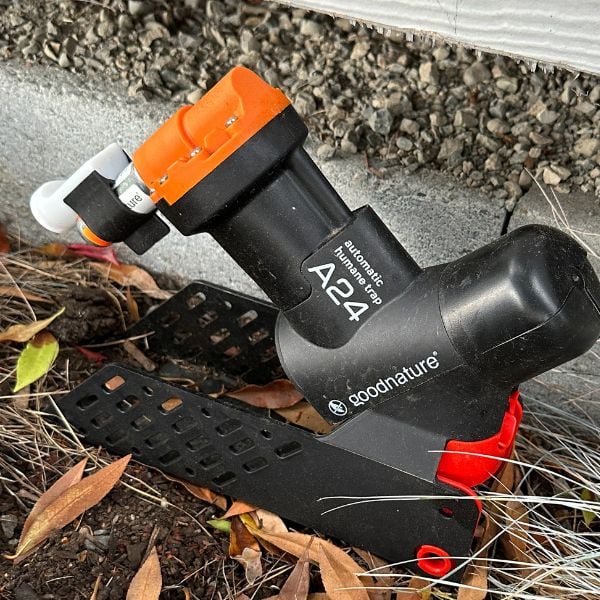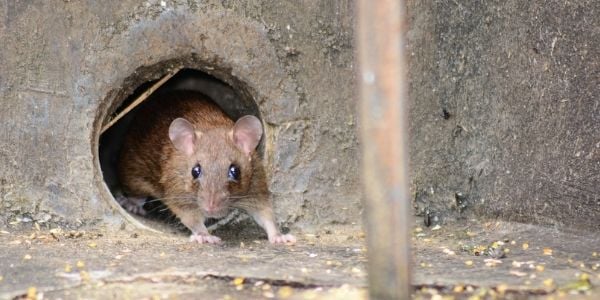
If you suspect your pet ate rat poison, time is of the essence. Take them to your veterinarian or an Animal ER, or call a pet poison hotline right away.
While most people know that rat and mouse poisons are dangerous for cats and dogs, what many people don’t realize is that not all rodenticides work (kill) the same way.
If you need to get rid of rodents in and around your home, there are pet-safer and, frankly, more humane choices.
It's also important to pay attention to what your neighbors are putting around their homes in case your pet gets into it or comes across a dead rodent. This is especially important if you live near a farm or agricultural area, or any commercial area. Commercial rat poisons (second-generation rodenticides) kill much more quickly than first-generation poisons. Read more about the differences between first- and second-generation rodenticides.
Skip to section:
Pet-Safer Rodent Control Options
Rats and mice may make cool pets, but they are generally not welcome visitors. And for good reason. They might be cute, but the problems they cause are far from it. They can spread diseases like Hantavirus, Leptospirosis, Monkeypox, Salmonellosis, and others. They can also cause fires by chewing on wires, be destructive to your home and furniture by gnawing and building nests, bring fleas and ticks into your home (which will likely affect your pets), and several more unpleasant things.
So, if you're convinced that getting rid of your rodents is important, then here are a few more humane methods that are also safer for your pets.
- Catch-and-Release: There are traps that can help you remove rodents from your home without poisons or mechanisms (e.g., snap) that could also sicken, kill, or otherwise harm your cats and dogs. There are a number of catch-and-release traps that capture a mouse or rat without killing them, giving you the option to release the trapped rodent somewhere away from your home.
Do your best to avoid leaving any "human" scent or disruption to the area. The bait should be changed every 2 to 3 days. Scatter some of the bait around the trap so they are lured to the area and to help hide your scent. You can try cooked bacon or sausage, peanut butter bites, nuts (almonds, pecans, etc.), fruit (soft types, like berries), and seeds (sunflower or pumpkin seeds). Make sure that if your pet is small enough to enter the trap, you place it somewhere they cannot get to it.
A note about glue traps: They don't use poison to kill the rodent, but that doesn't mean they are "no-kill." You still have to kill the live rodent on the trap or let them starve to death. And there's the added risk that your pet will get a glue trap stuck to themselves. NOTE: If you decide to save a mouse or rat from a glue trap, here's how: you can gently and carefully pour cold cooking oil (canola or vegetable) between the rodent and the glue trap. This video demonstrates how. Once free, you can release the mouse or rat in an area away from your home. Please remember, they can spread disease, so take precautions not to get bitten, wear gloves, and wash your hands thoroughly when finished.
- Electric Traps: Rather than bringing poison into your home, you can use a rodent trap that uses bait to lure the rodent in and then electrocutes them. It's suggested to use nuts or peanut butter as the lure. If your pet is tiny, they could get inside, and with the use of peanut butter, any dog will be interested, so keep this device out of reach.
- Goodnature Quick-Kill Trap: This trap kills humanely without electricity or poison. The lure is chocolate-based, but we contacted the distributor, and the toxicity level is not an issue for dogs or cats, but it can be enticing nonetheless. There's no real way a pet could be hurt by this type of trap, but it's still best to keep them away from it. You can buy it on Amazon or directly from the company.
- Bait Stations: Some traps are designed so rodents can get in and eat the poison, but not a cat or dog. These are safer than unprotected poison, but not completely safe. There’s always the chance of a poisoned rodent leaving the trap and then being eaten by your cat or dog (this is called "relay toxicosis" or "secondary toxicosis"). And you still have to be careful to safely store the poison refills.
Ways to Keep the Rats at Bay
These are some things you can do to help keep rats and mice away from your home without using traps or poisons.
- Tightly close all trash cans.
- Do not leave trash bags out – put them inside sealed trash cans.
- Be sure that all pet food and treats are stored in sealed containers.
- Be sure to put bird food in sealed containers and minimize what is left on the ground.
- Keep compost piles sealed. Avoid putting meat, dairy, or cooked/baked foods in the compost.
- If you have fruit trees or a berry patch, routinely clean up any that have fallen on the ground.
- Be sure to clean up and dispose of any pet waste in your yard.
- Plug up any holes or access points from the outside that lead into your home. You can use steel wool or copper mesh.
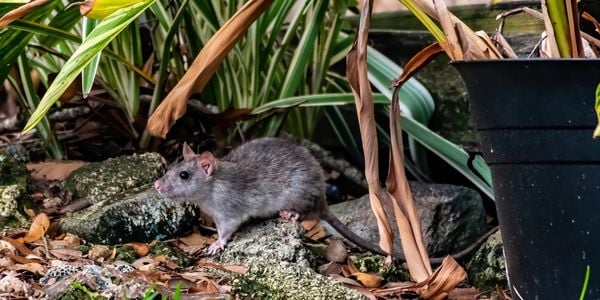
Dangerous Rodenticides and Their Ingredients
Exposure to rat poison remained on the ASPCA TopTen Pet Toxin List for over the last 5 years. While dogs and cats are not the intended "victims" of rat poisoning, sadly, they often are. In order to entice rodents to eat the bait, many of them are very tasty. Not only does it attract rodents, it attracts pets since they think it may be a yummy treat.
While many of the more common rodenticides kill by causing prolonged internal bleeding, not all do! Some kill by causing kidney failure, while others kill through their devastating effect on the cellular metabolism throughout the body. This difference in "mode of action" is extremely important, as they each carry their own probability of recovery and require different treatments.
The labeling for rodenticides is often categorized by its level of toxicity (why it is important to bring the package to the vet). Here are the three main categories and the rodenticides associated with them:
Highly Toxic Rat Poison Ingredients
- Aluminum phosphide
- Arsenic
- Barium carbonate
- Bromethalin – dose dependent and no antidote (treatment) (see more details below)
- Elemental phosphorus
- Sodium monofluoracetate
- Strychnine
- Thallium
- Zinc phosphide
- Rarely used or banned dangerous toxins
- Aldicarb
- Alpha-chloralose
- Disulfotetramine (TETS, tetramine)
- Pyrinuron
- Tetramethylene
Moderately Toxic
- Alpa-naphthyl thiourea (ANTU)
- Cholecalciferol
- Diaphacinone
- Dipazin
- Diphenacin
Toxic
- Brodifacoum
- Bromodialone
- Chlorophacinone
- Difenacoum
- Difethialone
- Norbormide
- Red squill
- Superwarfarin
- Warfarin
NOTE: Even though the third category may seem"less" toxic, pets can and will die if not treated promptly.
How Veterinarians Decide On the Appropriate Treatment
If your pet has eaten rat poison, it is important to bring the packaging if you can or safely bring some of the leftover poison to the veterinarian. Knowing the mode of action that the rodenticide uses to kill rats and mice (and cats and dogs) helps in determining the best course of treatment.
Modes of action for rodenticides that your pet may be exposed to:
Alpha-chloralose: Causes depression or a slowing down of the central nervous system
Brodifacoum: Causes internal bleeding
Bromadiolone: Causes internal bleeding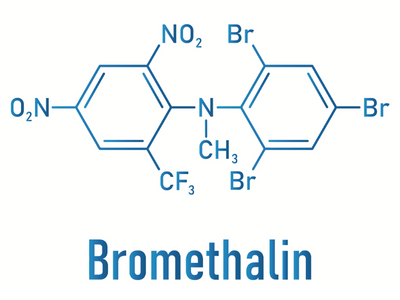
Bromethalin: Causes brain swelling by preventing brain cells from making energy from oxygen
Note: Bromethalin is a particularly dangerous type of rodenticide! It doesn't take much to cause problems, and unlike the anticoagulant rodenticides (those that cause bleeding), there isn’t an antidote (medicine or remedy)!
If it is known that a pet has consumed Bromethalin but is not showing any symptoms, seeking prompt veterinary help is still critical. It is necessary for "decontamination" measures to be taken. If it has been within 4 hours of ingestion, it will include inducing vomiting and administering activated charcoal (this helps keep the poison from being absorbed into the bloodstream). It will also be necessary for the pet to be placed on intravenous fluids and hospitalized.
For pets that are showing visible symptoms (e.g., vomiting, muscle tremors, weakness, seizures, etc.), decontamination is done via gastric lavage (flushing of the gastric contents under anesthesia). Additional supportive care, such as intravenous fluids and medications to manage seizures, tremors, and brain swelling, may be necessary.
Once neurologic signs are present, like seizures, tremors, etc., the prognosis is grave as their brain is swelling and there is no antidote (treatment). Be extremely careful with this poison, and should your pet ever get into it — 100% do not hesitate to seek immediate veterinary attention.
This isn't an exhaustive list of active ingredients, but these are common:
Cholecalciferol: Causes severe acute kidney failure and calcification of the soft tissues.
Chlorphacinone: Causes internal bleeding
Difethialone: Causes internal bleeding
Diphacinone: Causes internal bleeding
Strychnine (not as commonly used): Causes severe muscle tremors and spasms
Warfarin: Causes internal bleeding
Zinc, Magnesium, and Aluminum Phosphide: Causes a poisonous gas (phosphine) to be created after it interacts with stomach acid. This results in damage to blood vessels.
Be Aware! There is a compound called Aldicarb that is an extremely potent and deadly poison. It kills fast! According to the National Pesticide Information Center, Tres Pasitos, which means "three little steps," is a poison typically imported illegally into large cities from the Dominican Republic, Mexico, and some other Latin American countries. It is very nasty stuff!
DIY and 'All-Natural' Rodent Poisons Are Still Dangerous for Pets
There are DIY versions of rat poison that people can make at home. The problem with this is that the main ingredient, or what it is mixed with, can be just as toxic as the poison you buy in the store.
Large amounts of these DIY rodent baits and repellents are often needed to be effective. So, just like rodents don’t know when to stop eating, neither do most pets. This increases the risk of toxicity.
Examples of Homemade Rat Poisons That Can Be Toxic to Your Pet
Ammonia: The strong smell of ammonia is meant to repel rats. While it is not common for pets to consume it, it can happen, resulting in chemical burns in their mouth and throat. If they step in it, it can cause burns on their skin. The strong scent can result in respiratory issues, which can be dangerous for all pets but most especially those with asthma and other respiratory issues.
Onions: Rats do not like onions – cooked or uncooked. They will generally avoid them unless they happen to be masked with other highly tempting ingredients. Onions are toxic to dogs and cats. Some pets will even eat them alone and raw. The risk of consumption and toxicity is increased when they are mixed with other ingredients that may also be toxic.
Baking soda mixtures: If pets consume large quantities, baking soda can be toxic. Ingestion of 10–20 g per kilogram (2.2 pounds) of body weight has resulted in toxic effects. On average, this would be equal to about 2–4 teaspoons per kilogram of body weight. Some rat bait recipes recommend mixing it with chocolate powder, which can be highly toxic as well.
Cement powder mixtures: Cement powder itself, in small amounts, is not toxic. But consumption of large quantities can be toxic, especially for small dogs and cats (5 grams can kill a cat or kitten). Generally, recipes call for it to be mixed with peanut butter (which could contain xylitol) or cocoa powder (which is toxic). Both of these additions are very appealing to pets and increase the risk of toxicity.
Boric acid mixtures: Besides borax (boric acid) itself being toxic to pets, it is often mixed with chicken broth that may contain onions and garlic, which are toxic to pets.
OTC Vitamin D-3 supplement: This is similar to the active ingredient in many rat poisons. These tablets, usually 5000 IU, are crushed and mixed with peanut butter. For pets, as little as 0.1mg/kg (about 0.45mg/10lb of body weight) can be toxic, and 2mg/kg can be fatal.
Black pepper: While black pepper is not directly toxic, the items it is mixed with can be. Additionally, the consumption of larger quantities of black pepper (though the exact dose is not known) can increase the absorption of certain medications, resulting in toxic effects.
Plaster of Paris: While the plaster itself isn’t toxic, it can cause gastrointestinal upset (vomiting and diarrhea). If large quantities are consumed, it may result in an intestinal blockage, as the plaster hardens, which can be fatal if not treated in time. Some recipes call for it to be mixed with chocolate powder, and depending on the type used, it can result in toxicity for your pet.
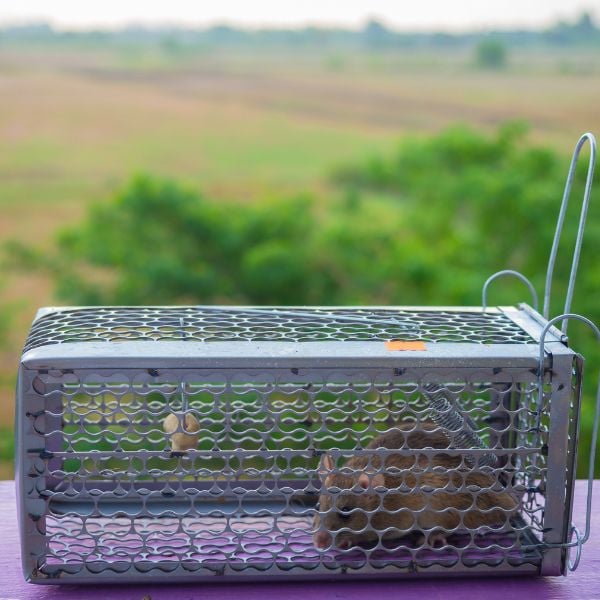
We hope you use a pet-safer option if you have a rodent problem.
If you have any questions, ask us below, and we'll do our best to help.


